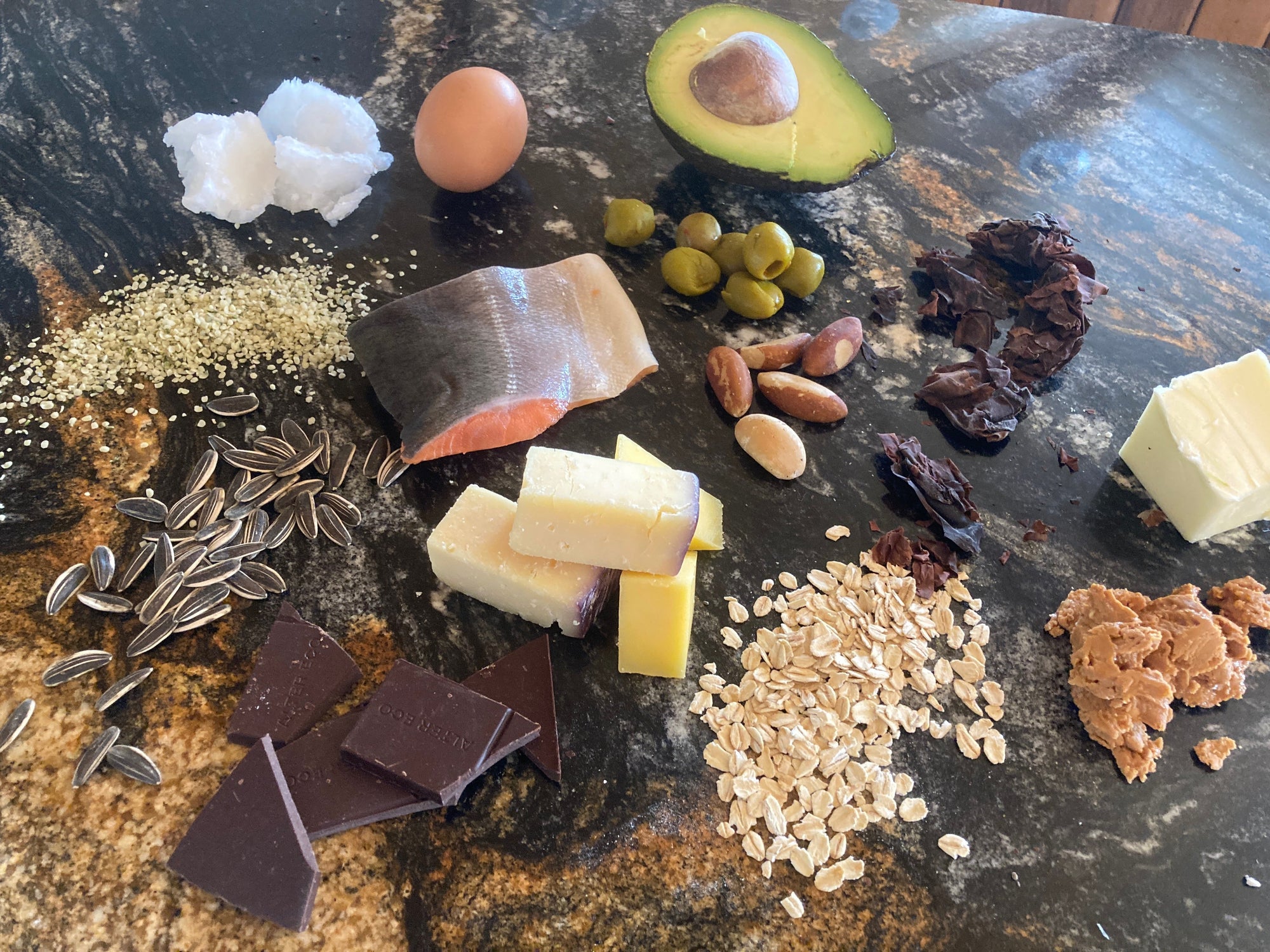

· By Gareld Eaton
The Endocannabinoid System: Part 3. Why Chewing the Fat Makes a Difference
As mentioned in the prior post, research on our own “classical” endocannabinoid system (ECS) was based on the cannabis plant, and how it impacted humans. This research discovered that we humans produce two main endocannabinoid compounds that activate the system, anandamide and 2-AG. They both can fit into the two main receptors, the CB-1 and CB-2 receptors, to varying degrees.
As I understand it, these compounds are made in our cell membranes, can go when and where needed, and are broken down after they are used. The receptors for the endocannabinoids are located everywhere throughout the body, and in all the body’s fluids. Remember, most CB-1 receptors are abundant in the brain and spinal cord, (also in the lungs, liver and kidneys), and most CB-2 receptors are mostly in the immune system (also in stem cells, and some parts of the brain). Endocannabinoids can cross the blood-brain barrier and travel through the circulatory system. So when anandamide or 2-AG bind receptors, effects may be felt either all over, or just locaIIy, based on the body’s needs, and where the receptors are.
This “classic” ECS system view continues to expand, thanks to ongoing studies. As mentioned in the previous blog, we now know that there are more receptors that can be activated by our endocannabinoid compounds, and more compounds that can activate these receptors, in addition to the classic two (anandamide and 2-AG). This means that the cannabinoids from cannabis and our own endocannabinoids are not the only compounds that can influence our ECS.
We now know the compounds which help form our endocannabinoids. There are also certain cannabinoid-like compounds that can bind our receptors, and activate them, different than the classic endocannabinoids. New research has found compounds that can block our ECS receptors, strongly bind our receptors, bind our receptors in different locations, prevent the breakdown of our endocannabinoids (keeping the endocannabinoids around longer), build endocannabinoids or endocannabinoid-like compounds, or fit into other receptors which somehow impact our ECS activity. All these actions can regulate endocannabinoid levels, and affect our health.
Scientists call these additional compounds “cannabinomimetics”, or the “extended endocannabinoid system”. And diet is the largest source of them. This is just the tip of the cannabinomimetics iceberg, as research continues to expand.
Our body maintains a baseline endocannabinoid tone, which is affected by our genetics, lifestyle, environment, and diet. Stress, pain, inflammation, sleep disruption, excess food intake, injury (and likely even more stimuli) disrupt the system, whose job it is to restore balance to our entire body.
Some stimulation of the ECS is beneficial, but too much is not. Excess intake of some of these compounds can overstimulate the CB1 and CB2 receptors, and create excess anandamide and 2-AG in the body. This unresolved ECS overstimulation causes inflammation, food craving, obesity, sugar/insulin imbalances, and worse. Mild activation of the classic CB-1 and CB-2 (and other related) receptors is needed for physical and emotional well-being. Our ECS is a complex network of back-and-forth communication among all these factors.
Sadly, we don’t know (yet) what is too much, too little, or just right. I have reviewed many studies and selected from the best among them to guide us here. This blog hopefully offers some insights into the foods and food compounds which interact with this system, to help keep both you and your ECS in balance.
In this blog, I am focusing on diet, as what we eat becomes who we are, especially if it contains fats—the greatest source of what impacts our ECS. Fat may be better than you think!
Diet & the ECS
Fats
Both of our endocannabinoids, anandamide and 2-AG, are made from the common fatty acid, linoleic acid. This may help us focus on the best starting place for supporting our ECS. This fat is part of every single one of our cell membranes, and is an Omega-6 essential fatty acid. Since we need it for essential functioning, and our body doesn’t make it, so we must get it from our diet.
It’s reasonable to deduce that foods rich in this fat may influence the ECS, because both of our endocannabinoids start their assembly as linoleic acid. But it’s not only foods with this fat (an unsaturated/PUFA /Omega-6 fat found in most plants and animals), that are active. It seems all foods containing fats are active in some ways for the ECS—this means both saturated and unsaturated fats and related fatty compounds, from both plants and animals—are all impactful.
Since both anandamide and 2-AG are built from linoleic acid, they can both be broken down to arachidonic acid, an acid which is both beneficial and inflammatory, as is the ECS. It’s about keeping our system in balance, and maintaining homeostasis.
Omega-6 fats (in plant oils, mostly) and Omega-3 fats (in fish oils, mostly) are types of unsaturated fats we are encouraged to eat. These, in addition to the saturated fats in plants and animals, and the many fatty-acid-derived compounds, all affect the ECS. These fatty-acid-derived compounds are similar in structure to the classic endocannabinoids. And while they don’t bind the CB-1 or CB-2 receptors directly, they still impact the endocannabinoid system and its responses. They also play a critical role in our body’s health. Yes, there are beneficial plant- and animal-derived unsaturated and saturated fats. We need to look at our diets, and aim for a balance between the fats we take in.
Recent research tells us that our Western Diet is too high in these inflammatory (mostly plant) Omega-6 oils, which are most of the oils we are taught to cook with—they have a very narrow therapeutic window. Too much of them disrupts our health. Keep canola, soybean, sunflower, corn oil, cottonseed, hydrogenated oils and grain-raised meats at a minimum. While both Omega-6 and Omega-3 fats are needed for the human body to function, taking in more Omega-6 foods has been shown to contribute to many chronic inflammatory diseases. So avoid over consuming them.
The Omega-3 (mostly fish) oils can help balance out the inflammation of excess Omega-6 oils. Research also suggests that a balance of Omega-3 to Omega-6 fatty acids is best at 1:1 to 1:4 (it is currently 1:8 to 1:20 in Western diets). These healthy Omega-3 oils are high in wild salmon, mackerel, sardines, seaweed, soybeans, chia, perilla and hemp oil, walnuts, flax seeds, and pasture-raised animals. These fats reduce excess anandamide and 2-AG endocannabinoids, keeping our obesity risk (and our ECS) in balance.
Aside from the Omega-3 and Omega-6 unsaturated fatty acids, there are additional healthy fats in foods, even from animal meats and dairy. CLA (conjugated linoleic acid), an unsaturated fat from (ruminant) animals is one. CLA may decrease anandamide levels in the brain, which may help prevent obesity. There is evidence for it regulating body fat, along with having anti-diabetic and anti-cancer benefits. Milk and meat from beef, sheep, goats, deer, bison, elk, antelope are all ruminant sources. I’d recommend buying grass-fed, organic or hormone-free meats, which have more CLA.
In addition to the Omega-3 and Omega-6 fats, there is a family of bioactive fats called n-acylethanolamides (NAEs), many of which are similar to our endocannabinoids, but, again, do not bind the cannabinoid receptors. They may, instead, inhibit the breakdown of our endocannabinoids, keeping them around longer. Or they may work via other receptors yet to be discovered. Since they do impact the ECS, they are considered “endocannabinoid-like” compounds. These fats are found in our foods, and are also made within us, from the breakdown of fatty foods from our diet. Here are LEA, OEA, PEA, and SEA--a few of the major ones and their activities. Included are the foods containing the whole fat as well as the starting fat which makes them. The list is by no means complete, as research is ongoing:
LEA/linoleoylethanolamide is an unsaturated fat found in our brain, some body fluids, and immune cells. It’s made from dietary linoleic acid, the same starting compound as anandamide and 2-AG. It has endocannabinoid-like activity with anti-inflammatory and pain-relieving properties. Although it does not bind either of the two endocannabinoid receptors, it keeps anandamide around longer by inhibiting its breakdown. Some foods contain LEA directly, including dark chocolate, cocoa, soybean oil and a sake byproduct (sake lees). Linoleic acid-rich foods include eggs, most meats, soybean oil, and even low-fat fruits, vegetables and grains.
OEA/oleoylethanolamide is an unsaturated fat made in our gastro-intestinal tract from the breakdown of dietary oleic acid. It has anti-inflammatory and appetite-suppressing activity, and helps prevent anandamide from breaking down, keeping more levels in the bloodstream. Foods which contain OEA directly include cocoa powder, nuts, and oatmeal. Oleic acid food sources include avocados, beef, cheese, chicken, cocoa powder, milk, nuts, oatmeal, olive oil, pork, sunflower seeds.
PEA/palmitoylethanolamide is a saturated fat found in our cell membranes and digestive tract, and is made from palmitic acid from our diet. PEA itself is found in soybeans, soy lecithin, roasted coffee, peanuts, corn, walnuts and egg yolks. PEA may influence anandamide production, but not via the classic receptors. Other studies show it actually may stimulate CB-2 receptors, as well, increasing anandamide in the digestive system, and slowing transit time. It has pain-relieving and anti- inflammatory benefits, especially in the digestive tract. Palmitic acid foods are found in avocadoes, butter, cheese, chocolate, eggs, meat, milk, palm oil, soy lecithin, soybean oil, and walnuts.
SEA/stearoylethanolamide is yet another saturated fat in the NAE family. It is made in our body from foods containing stearic acid. Foods high in stearic acid include beef and beef tallow, Brazil nuts, butter, cayenne pepper oil, cheddar cheese, cocoa, cream, duck, lard, parmesan cheese, pork, and sheep. SEA impacts CB-1 and CB-2 receptors in the brain, increasing 2-AG. It is neuroprotective and anti- inflammatory in animal studies. SEA directly is found in human milk.
Leelamide from lauric acid is a novel fatty acid. It is a saturated fat only found in vegetables, with the highest amounts found in coconut milk/oil and palm kernel oil. It has weak activity with the CB-1 and CB-2 receptors. It has anti-inflammatory properties, and may reduce harmful cholesterol. There are no published studies as yet on its pharmacology. This is another exciting area available for more research.
Chocolate, a food rich in many fats, has long been touted for its anandamide content, but was recently found to contain NO anandamide. Instead, it contains three NAE compounds (see above), OEA/oleoylethanolamine, from oleic acid, and LEA/linoleoylethanolide, from linoleic acid (the starting point of anandamide and 2-AGproduction in the body). LEA and OEA inhibit the breakdown of anandamide and keep more of it around longer. Chocolate also contains healthful and anti-inflammatory stearic acid. Yum! Side note: Dark chocolate has a cornucopia of health benefits. But that’ll be for another blog.
Without tedious fat calculations before every meal, just enjoying the Mediterranean Diet affects the ECS in a positive way, gathering many of these foods together into an overall food plan. It reduces excess anandamide, increases helpful gut bacteria, promotes brain health, improves insulin sensitivity and reduces systemic inflammation. The Cleveland Clinic has a good explanation of this approach to eating: https://my.clevelandclinic.org/health/articles/16037-mediterranean-diet
TL;DR Our diet is the largest source of compounds to make an impact on our Endocannabinoid System. Many dietary fats directly or indirectly influence it, including saturated and unsaturated fats, from animal and plant sources. It is important to keep the (mostly fish) Omega-3 fats and the beneficial grass-fed pastured animals (and their dairy) in our diet, along with fewer (mostly plant) Omega-6 foods. This will help maintain the fat balance and avoid the excess stimulation of our system. The Mediterranean\ Diet is a useful guide to keeping our food intake in balance. Balance within is what the ECS is all about.
In addition to all these above fats and their foods, are there some other aspects of our diet that help our ECS? Stay tuned for Part IV.

